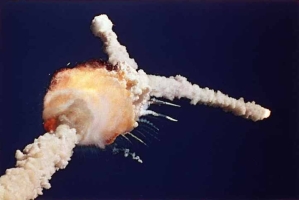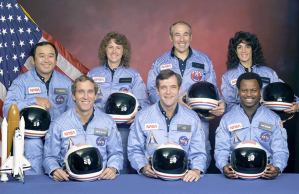
Twenty nine years ago today, students across the nation huddled together, crowded around metal TV carts eagerly anticipating what was to be a positive historic event.
It was 1986, and television had been newly introduced in the classroom. It had opened up a bright new world of education along with the opportunity to witness history in real-time - something unknown to previous generations. Elementary, junior high and high school students tuned in to witness the takeoff of the space shuttle Challenger.
On that Tuesday morning at NASA's Kennedy Space Center in Cape Canaveral, Florida, seven astronauts waved goodbye, hugged their families, posed together for photos and -with helmet tucked under the sleeve of their blue jumpsuits - headed off to meet their destiny.
But what made this launch different - what caught the attention of educators all over the country - was the ambition of one of their own. On July 19, 1985, a fellow teacher was chosen to experience something only a handful of people have embarked on in the history of mankind.
Sharon Christa McAuliffe, a 37-year-old high school teacher from New Hampshire was selected from a pool of 11,400 applicants to participate in a program to put "ordinary people" in space. A wife and mother of two, she had an intense interest in common people throughout history, had plans to conduct two live teaching sessions during the flight, and became a symbol of hope to teachers around the country.
"I'm hoping that this is going to elevate the teaching profession in the eyes of the public and of those potential teachers out there," she said during training. "And hopefully, maybe one of the secondary objectives of this is students are going to be looking at me and perhaps thinking of going into teaching as professions."

Speaking those words of encouragement and optimism, McAuliffe had no idea that hers would become a household name overnight, and that she would be honored each year as Americans remembered the crew of one of the most horrific space shuttle accidents in the history of the U.S. space program.
McAuliffe said numerous times that she had no fear when thinking about the mission, and joked with reporters that she felt "safer traveling to space than driving the streets of New York."
But her flight time on the Challenger's STS-51L mission would last just 73 seconds.
After several weather-related delays, it finally took off at 11:38 a.m. Less than two minutes later - caused by what would be determined as a faulty O-ring seal that allowed the escape of pressurized hot gas - the Challenger exploded in a ball of fire. The world watched as news cameras zoomed in on debris raining down into the Atlantic Ocean.
In an instant, the entire crew was gone.
Killed in the explosion were the mission commander, Francis R. (Dick) Scobee; the pilot Comdr. Michael J. Smith of the Navy; mission specialists Dr. Judith A. Resnik, Dr. Ronald E. McNair and Lieut. Col. Ellison S. Onizuka of the Air Force; and payload specialists Gregory B. Jarvis and McAuliffe.
President Ronald Reagan, originally scheduled to give a State of the Union address, instead spoke on the disaster that had rocked the country just hours before.
"Nancy and I are pained to the core by the tragedy of the shuttle Challenger. We know we share this pain with all of the people of our country. This is truly a national loss," he said.
The President spoke of the courage of the entire crew, of their place in history as pioneers in the space program, and publicly mourned the loss of the Challenger Seven.
"The crew of the space shuttle Challenger honored us by the manner in which they lived their lives. We will never forget them, nor the last time we saw them, this morning, as they prepared for their journey and waved goodbye and "slipped the surly bonds of earth" to "touch the face of God."
McAuliffe was the first educator chosen to participate in NASA's Teacher in Space Project and it was this notoriety that caught the attention of teachers around the world, prompting them to tune in with their students to watch the flight.
But what many schoolchildren walked away with that historic day was a defining moment in their childhoods, a chilling memory that remains vivid nearly 30 years later, one that exposed their young minds - perhaps for the first time - to the brevity of life and the courage of their fellow Americans.
For more information on NASA's Day of Remembrance for its fallen space program heroes please visit http://www.nasa.gov/.







